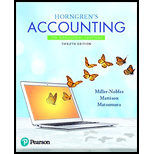
Account Receivables: For any delivered goods or services, the cash owed by the customers that they need to pay to the business is called account receivables. In the
Determine the following with reference to the books of the Canyon Canoe Company-
1. Amount of
a. Percentage of sales method
b. Percentage of receivables method
c. Ageing of receivables method
2. Journal entry of Bad debts recorded by percentage of sales method
3. Journal entry of write-off of the Early Start Daycare invoice
4. Prepare T-accounts for
5. Show how the net accounts receivables will be reported in the balance sheet of the company as on June 30, 2019.
Want to see the full answer?
Check out a sample textbook solution
Chapter 9 Solutions
Horngren's Accounting (12th Edition)
- please provide answer properlarrow_forwardAccounting assessment qnarrow_forwardWilcox Vehicle Inspections specializes in inspecting commercial trucks that have been returned to leasing companies at the end of their contracts. Wilcox's charge per inspection is $75, and its average cost per inspection is $20. The owner wants to expand the business by hiring another employee and acquiring additional inspection equipment. The fixed costs for the new employee and equipment would be $4,500 per month. Required: How many inspections per month would the new employee have to perform to earn a profit of $2,000?arrow_forward
- A firm's days of sales outstanding are 23.4, days ofinventory on hand are 45.9, and the number of days of payables is 34.7. When credit sales are made by the firm, the buyer agrees to pay the balances owed in30 days. What is the firm's cash conversion cycle?arrow_forwardFlagStaff Ltd has a defined benefit pension plan for its employees. The company is considering introducing a defined benefit contribution plan, which will be available to all incoming staff. Although the defined benefit plan is now closed to new staff, the fund is active for all employees who have tenure with the company. In 2020, the following actuarial report was received for the defined benefit plan: 2020/$ Present value of the defined benefit obligation 31 December 2019 18 000 000 Past Service Cost 4 000 000 Net interest ? Current service cost 600 000 Benefits paid 2 000 000 Actuarial gain/loss on DBO ? Present value of the defined benefit obligation 31 December 2020 21 000 000 Fair value of plan assets at 31 December 2019 17 000 000 Return on plan assets ? Contributions paid to the plan during the year 1 500 000 Benefits paid by the plan during the year 2 000 000 Fair value of plan assets at 31 December 2020 27 500 000 Additional information (a) All…arrow_forwardProduction during the year?arrow_forward
- Accurate Answerarrow_forwardMoti Bakery produces various baked goods. Utility costs are allocated to the products based on the baking time required for each product. Total utility costs of $270,000 are budgeted in a period when 540,000 total minutes of baking time are anticipated. If a batch of bagels bakes for 25 minutes, what amount of utility cost will be allocated to the bagels? I want answerarrow_forward4 POINTSarrow_forward

 AccountingAccountingISBN:9781337272094Author:WARREN, Carl S., Reeve, James M., Duchac, Jonathan E.Publisher:Cengage Learning,
AccountingAccountingISBN:9781337272094Author:WARREN, Carl S., Reeve, James M., Duchac, Jonathan E.Publisher:Cengage Learning, Accounting Information SystemsAccountingISBN:9781337619202Author:Hall, James A.Publisher:Cengage Learning,
Accounting Information SystemsAccountingISBN:9781337619202Author:Hall, James A.Publisher:Cengage Learning, Horngren's Cost Accounting: A Managerial Emphasis...AccountingISBN:9780134475585Author:Srikant M. Datar, Madhav V. RajanPublisher:PEARSON
Horngren's Cost Accounting: A Managerial Emphasis...AccountingISBN:9780134475585Author:Srikant M. Datar, Madhav V. RajanPublisher:PEARSON Intermediate AccountingAccountingISBN:9781259722660Author:J. David Spiceland, Mark W. Nelson, Wayne M ThomasPublisher:McGraw-Hill Education
Intermediate AccountingAccountingISBN:9781259722660Author:J. David Spiceland, Mark W. Nelson, Wayne M ThomasPublisher:McGraw-Hill Education Financial and Managerial AccountingAccountingISBN:9781259726705Author:John J Wild, Ken W. Shaw, Barbara Chiappetta Fundamental Accounting PrinciplesPublisher:McGraw-Hill Education
Financial and Managerial AccountingAccountingISBN:9781259726705Author:John J Wild, Ken W. Shaw, Barbara Chiappetta Fundamental Accounting PrinciplesPublisher:McGraw-Hill Education





